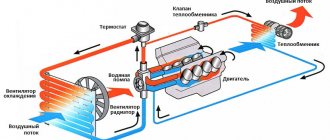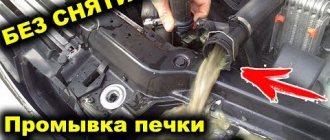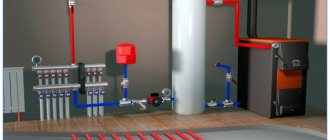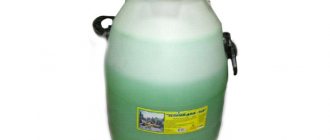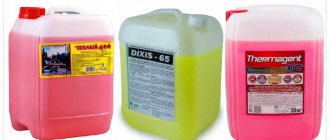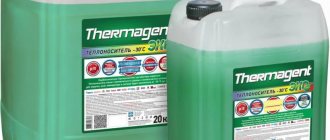Every owner who has installed aluminum radiators in a house or apartment is concerned about extending their “life,” the efficiency and safety of their operation. Often the answers lie in the quality of the coolant.
In apartment buildings connected to a centralized heating system, there is no need to talk about the composition and Ph level of the water, since after it runs under pressure through the numerous pipes of the heating main, suspensions and dirt are constantly present in it, which affect it.
It’s a different matter when it comes to an autonomous heating system, which gives a person the right to choose what to use, water or special antifreeze for aluminum radiators.
Antifreeze properties
Consumers are so accustomed to using water as a coolant that they do not even suspect that there are liquids of better quality. Water's biggest advantage is its cost and non-toxicity, but otherwise it can be an enemy for a heating system. Its ability to cause corrosion in metals has “ruined” more than one generation of radiators.
In addition, in the event of an accident on the heating main in winter, when the heating is forced to not work, it can freeze in the pipes even at zero temperature. Its ability to expand, both when frozen and heated, causes them to rupture.
Antifreeze, enriched with special additives for use in heating systems, has some advantages next to water, but it also has negative qualities:
- This coolant freezes at -70 degrees.
- It does not harm aluminum, which is very important for such a “sensitive” metal.
- It has a good level of thermal conductivity, although it takes a little longer to heat up than water.
These were the positive qualities of antifreeze. Among its disadvantages:
- It has a higher viscosity, so to move it through the heating system you need a fairly powerful boiler.
- The fluidity of antifreeze poses a threat if the integrity of the joints or elements of the heating network is compromised.
- Antifreeze is toxic, so precautions should be taken when using it.
Many consumers wonder, knowing about these shortcomings, whether it is possible to use antifreeze in aluminum radiators. In this case, it is even preferable when it comes to an autonomous heating system. The durability of this coolant is enough to heat a house for 10 winters, which in itself is good news. During this period, aluminum batteries do not change at all under its influence, which also has a positive effect on their service life.
Types of coolant
Water is the most popular and accessible coolant for water heating circuits. However, due to its use as a coolant for aluminum heating radiators, the metal begins to rust, and scale and deposits appear inside the pipes. Therefore, such systems require periodic flushing and cleaning. Also, during winter shutdowns, there is a real danger of freezing: in such cases, it is necessary to drain the water. If this is not done, freezing of the liquid will certainly lead to rupture of pipes and batteries.
All this indicates that, in addition to correctly calculating the power of the batteries for the room, it is important to use exactly the coolant that is not afraid of freezing and chemical interaction with metal walls. It is important to keep in mind that such special solutions do not have a negative impact on human health when the circuit leaks.
We are talking about antifreeze: this coolant is not afraid of low temperatures, which is facilitated by additives and additives dissolved in the liquid, which act as inhibitors of corrosion and mineral deposits.
Types of antifreeze
Depending on what substance is added to distilled water, the technical characteristics of antifreeze change.
- Glycerin works well as an additive; it is non-toxic and highly soluble, which allows it to be used in the system for a long time without fear of precipitation.
- Ethylene glycol-based antifreeze is the cheapest and most toxic. The second indicator concerns its ingestion, when it can lead to death. If you handle it carefully and check the system for integrity, it will not cause harm and will serve for a long time inside aluminum radiators.
- Propylene glycol is the best addition to distilled water in the production of antifreeze. It is non-toxic, does not produce residue, and its only drawback is its rather high price.
Since ethylene glycol-based antifreezes are very popular due to their cost, before purchasing such a product, you need to check its compatibility with the heating system. Such a carrier is used exclusively in autonomous systems with a single-circuit boiler, since if it gets into water, it can cause serious poisoning, even death.
Antifreeze containing ethylene glycol cannot be used in open heating systems. In the case of fumes, the damage can be equally irreparable.
On the other hand, coolants that include propylene glycol or glycerin are completely safe and can be used in all types of individual heating systems.
Historical excursion
To begin with, I’ll briefly talk about the history of engine building. The first motors were designed and implemented about two hundred years ago. Previously, there were no antifreezes, and they had not yet figured out how to use water as a coolant. As a result, the engine was cooled naturally - using air.
Literally a few years later, a water-cooled motor appeared, which subsequently began to be actively introduced. The first antifreezes were developed only in the 19th century, and were produced in the form of layered, alcohol or glycerin (with the addition of sugar and honey) formulations. Only at the beginning of the 20th century did substances protect internal combustion engines from the negative effects of corrosion go on sale.
How to choose the right antifreeze
In order for the coolant to be truly effective, you should know which antifreeze for aluminum radiators is optimal.
- Any type of antifreeze has a heat capacity lower than water, so more radiator sections will be required.
- The battery size should also be different. Since this coolant expands greatly when heated, it needs 50% more capacity than water.
- You should make sure that the boiler in the heating system is suitable for working with antifreeze.
- All joints need to be checked and made sure that the seal is not broken. If flax fiber is used as additional gaskets in the heating network, it will have to be replaced with rubber analogues.
- Antifreeze is not friendly with zinc, so you need to check all fittings and pipes to ensure that there are no products made of this metal among them.
Antifreeze coolant does not have to be purchased at the store. It is quite easy to make with your own hands from distilled water and 40% alcohol.
Types of coolants for aluminum radiators
Installation of aluminum radiators.
The most common coolant for a heating system is water, but it sometimes leads to numerous difficulties. This is not only corrosion, but also the formation of scale, the need for more frequent cleaning of the system. In addition, water freezes already at temperatures close to zero degrees, pipes and individual circuit elements can simply burst due to thermal expansion. Therefore, it is important not only to choose the right batteries, but also to use a non-freezing coolant. Among the advantages, it is necessary to note complete safety for humans. If the system leaks, there will be no harm to health, while antifreeze is poisonous.
How to pour antifreeze into the heating system
As professionals advise, a heating system using antifreeze should be planned before installing it. It must take into account such nuances as the power of the boiler, the material of the pipes and shut-off devices, the presence of an expansion tank through which the coolant is supplied to the system.
If the product is introduced into a system that previously operated on water, then a lot of work will have to be done to recalculate the power and size of its radiators, thoroughly rinse or replace the pipes.
If you need to add coolant to the heating system, you can only use the same brand as when filling it for the first time. Different types of antifreeze enter into a chemical reaction, causing the formation of sediment, and the additional additives they contain will be neutralized.
To summarize, we can say that non-freezing coolant has a number of advantages that attract many consumers. Thanks to antifreeze, aluminum radiators last much longer. It is important to follow safety rules and not use the product without protective gloves, and in the case of an ethylene glycol-based carrier, also a mask.
Everyone knows a few jokes about how a newbie/blonde filled a diesel car with gasoline. Everyone laughs at the sign “I’m confusing the pedals.” But are we all sure that when the time comes or, God forbid, there is a problem with the engine, we will choose the right antifreeze? We tell you how to become an expert in these liquids.
The most popular brands of refrigerants
Today there are several brands that deserve attention from drivers. The following companies produce good auto chemicals for aluminum engines:
- "Tosol-Sintez" A Russian company that produces antifreezes of the popular Felix line. There are four types of compounds that have different properties.
- Liqui Moly. German manufacturer. The compositions from this company are very high quality and today are among the leaders in sales.
- Motul. A French company that pays special attention to the biological safety of materials and the complete safety of users.
- "Obninskorgsintez" A Russian brand engaged in the development and production of Sintec antifreeze.
Various antifreezes are popular in Russia. In addition to these, we can also highlight Long Life and Nord.
I have red antifreeze - do you have red?
Antifreezes, which are used by automakers for filling at the factory, are liquids consisting of 4 components:
- demineralized water
- ethylene glycol (in Volkswagen cars can be replaced by glycerin, but not more than 20%)
- a package of additives that stops severe corrosion of metals and corrosion of polymers of the cooling system from ethylene glycol
- dye
The first 3 components are transparent. The dye is added so that antifreeze from different manufacturers differs in some way in appearance, except for the label and the color of the canister (many brands even use the same canister - for example, Volvo, Land Rover, Motul).
When choosing antifreeze, you cannot focus on color. You only need to look at the tolerance of antifreeze, by analogy with oils. Therefore, either the original or a rebrand of the original.
Advantages and disadvantages
When choosing antifreeze to fill into a radiator, you should select a special composition intended for these purposes. Antifreeze refers to a special liquid that does not freeze at low temperatures. Special solutions for heating circuits contain special impurities and additives that do not harm the radiator and maintain its stable operation.
Among the negative aspects of antifreeze, several factors can be noted.
The thermal capacity of antifreeze is low. Such liquids are 115% inferior to water in this indicator. To use this coolant in a radiator, a special pump is required to start the entire system, since fluids for heating circuits have a high viscosity. Therefore, they must be accelerated by a pump for the system to start working. Antifreeze has high fluidity
For this reason, special attention should be paid to welds and connections on the radiator. Some compounds are extremely toxic and harmful to human health.
But despite the above-mentioned disadvantages of this type of coolant, it is perfect for use in aluminum circuits with an autonomous heating system.
I only need G12!
G11, G12, G12+, G12++, G13 are the specifications of Volkswagen antifreeze, which are applicable only to cars of this concern! If the owner of, for example, a Kia comes to the store and asks for G11 or G12 antifreeze, it’s the same as if he asked for oil with VAG 507.00 approval. Moreover, the G11 specification has not been used by VAG since 2012, G12 - since 2004! Now the concern's cars are equipped with G12+, G12++ and G13.
Therefore, if you do not have an Audi, Skoda, Seat, Volkswagen, Bugatti, Porsche, the G specification has nothing to do with you. You need antifreeze approved specifically for your car.
Benefits of ethylene glycol antifreeze
Antifreeze does not freeze at low temperatures. Pure ethylene glycol is a viscous, oily, colorless liquid with little odor. Its boiling point is +197 and its freezing point is -13 degrees Celsius. But in a dacha that is closed for the winter, the room temperature can be much lower.
To ensure that the ethylene glycol concentrate does not freeze and cause the heating system to fail, it is diluted with water and a solution is obtained, the freezing point of which can be as low as -70 degrees Celsius.
To make coolants, not only ethylene glycol is used, but also propylene glycol, but the latter ingredient has a higher viscosity and, therefore, greater density. And according to the laws of physics, it will have a higher freezing point. Therefore, experts often recommend the antifreeze composition G11 G12 based on ethylene glycol.
All antifreezes are the same
Today, global automakers use mainly three types of antifreeze: carboxylate, lobrid and hybrid. For example, if we take VAG antifreezes, then G11 is hybrid, G12/G12+ are carboxylate, and G12++ and G13 are lobrids. Hybrids use mineral salts (silicates, phosphates, nitrates, molybdates, borates) as the basis of an additive package, while carboxylate salts use organic acids and their salts, respectively. Lobrids are organic antifreezes, in which up to 9% of the additive package is based on mineral salts (silicates or phosphates). Hence the name of the technology, from Low+Hybrid - Lob-rid.
Technologies work in different ways. Hybrids form a thin film to protect system materials from corrosion, while carboxylates “stop” only the point of corrosion. For Ford cars, for example, silicate or phosphate film is very harmful to the radiator. Therefore, Ford, like Chevrolet, Land Rover use pure carboxylate antifreeze. But at BMW, on the contrary, they are not yet going to replace the hybrid technology, despite its venerable age.
Therefore, antifreezes, if we don’t talk about counterfeit products, are very different. And, we repeat, you need to choose antifreeze according to tolerance, and not according to the technology of the additive package or, especially, color.
Coolant
A coolant is a liquid intended for use in heating systems to transfer heat. In most cases, water or antifreeze is used as a coolant. It comes in two types - regular ethylene glycols and food grade propylene glycol. The type of coolant largely influences the service life of the heating device itself. This is why modern heating systems often use water. Despite the fact that it is highly corrosive and prone to salt formations, the water is environmentally friendly. In addition, it has high thermophysical properties. To reduce its corrosive properties and reduce salt formation, inhibitor additives are added to it. This improves its properties and allows you to increase the service life of the heating system. If there are concerns that you will need to defrost the system, then it is definitely better to choose antifreeze. Such a coolant also has high technical properties, which are inferior to water only in terms of thermophysical properties. Antifreeze is divided into several types, depending on the substance used for production, the crystallization temperature and the set of additives.
Antifreeze is mainly produced on the basis of ethylene glycol. This is a fairly toxic liquid that can cause corrosion in pipes and radiators. That is why it is diluted with other substances, including water. The coolant in the form of antifreeze is suitable for powerful boilers, since its heat capacity is 10-15% lower than that of water. It also has increased viscosity, it is necessary to select the correct pipes and fittings, they must have a larger diameter. Antifreeze can have different freezing temperatures -30°C and -65°C. In this case, a concentrated liquid with a temperature of -65 ° C can be diluted to the concentration you need. This coolant can be used in various heating systems, including underfloor heating systems. Antifreeze can be diluted in any proportions, this will reduce its corrosive properties and reduce the formation of salts inside heating systems. There are a huge number of different types of antifreeze, so you can easily choose the composition you need. It is distinguished by high quality and high technical properties, which goes well with an affordable price. The coolant has a warranty period, which averages 2 years, depending on its type and technical capabilities.
Antifreeze boiled - just a little bit!
If your antifreeze has run away, you have two possible problems:
- problems in the cooling system, usually with the radiator
- problems with coolant
The second is the most common situation. And in 90% of cases this happens with “methanol” mixtures - counterfeits of antifreeze, where expensive ethylene glycol is replaced with a cheap mixture of glycerin and methanol. The latter boils already at a temperature of 85⁰C in the system.
Therefore, if you boil, let the system cool and add water (preferably distilled). A methanol mixture diluted with water will not make the car any worse. However, make an appointment at a car service center as soon as possible and replace the fluid with the correct one for your car.
Benefits of ethylene glycol antifreeze
How do antifreezes differ in general? They do not freeze at fairly low temperatures. Pure ethylene glycol is a viscous, oily, colorless liquid with little odor. Its boiling point is +197 and its freezing point is -13 degrees Celsius.
But in a dacha that is closed for the winter, the room temperature can be much lower.
In order to prevent the ethylene glycol concentrate from freezing and causing the heating system to fail, it is diluted with water and a solution is obtained, the freezing point of which can be as low as -70 degrees Celsius.
For the production of coolants, not only ethylene glycol, but also propylene glycol is used, but the latter ingredient has the highest viscosity, and therefore the highest density.
And according to the laws of physics, it will have the highest freezing temperature. That’s why experts often recommend the antifreeze composition G11 G12 based on ethylene glycol.
I have Fill for Life antifreeze, which means I don’t need to change it!
Fill for Life - means for the entire service life... of the unit that uses this consumable. A little trick. Modern engines, radiators, pumps and turbines rarely run more than 150–200 thousand km. And this is exactly the period that high-quality carboxylate or lobride antifreeze should last.
When it comes to “homemade” antifreezes (not to mention methanol mixtures), 250,000 km or even more written on the label is just a figment of the imagination of marketers. After all, in order to confirm the declared mileage, antifreeze must pass a number of complex tests from automakers, tests according to international standards (for example, ASTM 6210).
In general, if you have original antifreeze or its rebrand, then yes - until any element of the cooling system is repaired, the antifreeze will work as it should. But this rule does not apply as soon as it comes to, for example, “Russian” developments that do not have test results officially confirmed by automakers.
Ethanol compounds
The significant cost of this antifreeze for aluminum radiators often becomes a serious obstacle to its use in private autonomous systems. The composition can be obtained from distilled water and 40% ethanol (ethyl alcohol). The quality of such a solution is superior to the factory analogue in certain parameters. The matter mainly concerns its low viscosity (although compared to water it remains quite high). There is also a decrease in fluid fluidity, which makes it possible to be less demanding on the connecting areas.
The use of homemade ethanol antifreeze for heating radiators has a beneficial effect on the safety of the rubber sealing gaskets that are present in any circuit. It is recommended to dilute alcohol with hard water: in combination with ethanol, it will become a serious obstacle to the formation of scale on the inner walls. In this case, you cannot do without solid sediment, but you can easily get rid of it by flushing the system. In cases where the percentage of ethyl alcohol in water does not exceed 30%, it will not evaporate.
Due to the fact that the coolant for aluminum radiators is similar in its characteristics to water, its boiling point is approximately the same as that of water. This suggests that when the temperature reaches + 85-90ᶷ, no steam release will be observed. Thanks to ethanol, the thermal expansion of water is reduced by an order of magnitude, which allows the system to more comfortably tolerate lower temperatures in the room.
Antifreeze is always the right choice
TOSOL is one example of how a trademark has become a category name by analogy with Xerox and “copiers”, Scotch adhesive tape and “scotch tape”, etc. TOSOL is a trademark of the Institute of Organic Synthesis, the name of which is formed from the words Technology of Organic Synthesis "tos-" and the typical ending of organic compounds - "-ol" (ethanol, methylbutanol, etc.).
This is a recipe from the 70s, developed in the USSR for engines of those times based on cast iron (block) and loads typical for units of that time. If we are talking about any modern engine that uses aluminum or other non-ferrous metal, or even more so about forced engines (turbocharged systems), “antifreeze” is something that simply cannot be used in such systems. Corrosion, cavitation, deposits in the system - all this awaits those who pour antifreeze even into a new LADA car (the engines of which, by the way, use carboxylate antifreeze).
Therefore, forget the word “antifreeze”. It doesn’t matter how old your car is, there is no point in buying antifreeze when you can buy orders of magnitude more advanced products - for example, carboxylate or lobride antifreezes approved for your car.
Safety rules when working with antifreeze
It is not recommended to mix products from different brands. If such a need arises, first check for compatibility. In addition, not all manufacturers use the same additives. These components can mutually neutralize. Then the anti-corrosion properties of the coolant are lost.
Experts do not recommend pouring antifreeze into an open system. The reason is an open expansion tank. Through it, harmful substances can enter the atmosphere. Therefore, when using “anti-freeze” it is recommended to make the system closed.
Open type heating systems are of little use for the use of antifreeze.
The home owner does not always know which product was used to fill the heating system last time. In this case, the pipes are completely freed from the previous product, and only then the system is filled.
Distilled water is used to dilute the concentrate. It should not contain calcium and magnesium salts. If you use tap water with a hardness higher than 5 mg-equivalent, there is a possibility of sedimentation.
If it is assumed that antifreeze will be used in the heating system, then you should pay attention to the characteristics of the radiators. Preference is given to models with higher heat transfer rates, internal volume and diameter
The pump power should be 60% higher than that of equipment working with water.
Hard water should not be used to dilute concentrated products.
Automatic air exhaust devices are not designed to work with such coolants. To make it possible to free the system from air, Mayevsky taps are installed on the radiators.
In the system, it is better to use inserts made of materials resistant to glycol media - paronite, Teflon, etc. Threaded connections are laid with flax tow, and a special sealing paste is used as a lubricant. Oil paint is not suitable. The active components of the coolant are good solvents for paintwork materials, as a result of which the system begins to leak.
Antifreeze concentrate is mixed with water in a separate container, and only in this form is the system filled. If you first add coolant and then water, the system may fail. Consequences of ignoring this rule:
- uneven heating of the system, and some radiators may be completely cold due to uneven distribution of the product;
- failure of the circulation pump;
- foaming, which makes it necessary to repeatedly empty and refill the system.
If by mistake you add concentrate and water separately, the circulation pump should not be turned on at full power. Take a wait-and-see attitude and periodically bleed air from the system through the radiators. After some time, more or less uniform mixing of water and antifreeze will occur. If the heating system is gravitational with a gravity function, then this process lasts longer.
Video - Disadvantages of using antifreeze in heating systems
Antifreeze should not be used in systems that do not have an accurate temperature controller. When the temperature rises to 70 °C and above, the coolant disintegrates, which is dangerous for the heating system.
After draining the antifreeze and before filling a new portion, the system is washed with clean water or special solutions.
Before refilling antifreeze, it is recommended to flush the heating system
I take the cheapest one, it's antifreeze!
To seriously save on antifreeze, use its most expensive part - ethylene glycol. Therefore, to reduce the cost of the product, ethylene glycol is replaced with viscous glycerin diluted with methanol. Glycerin and methanol cause significant damage to modern systems, corroding aluminum and polymers, causing cavitation and boiling off of liquids.
Methanol products on the shelf usually cost up to 300–450 rubles per 5 kg of antifreeze. Up to 600 rubles, there is also a huge chance of stumbling upon a repainted “antifreeze”, which on the label may have the words “Antifreeze”, “G11”, “G12”, “carboxylate”, “Recommended for Audi, BMW, Mercedes”, etc. These inscriptions are solely the opinion of the company’s marketers, which has nothing in common with the truth, since the antifreeze formulation will never pass the tests of the world’s automakers.
Considering that antifreeze is changed every 3-5 years - think about it! Saving 300–400 rubles once in 5 years, you will get either one of these problems, or perhaps all of them:
- pump replacement
- radiator replacement
- 5% increase in fuel consumption
- reduction in the actual life of engine oil by 10–20%
Therefore, it is recommended to choose products that have official antifreeze approvals for your car brand (and sometimes a specific engine). Unfortunately, the choice is not wide - it is either the original antifreeze from the manufacturer, or its rebrand - the same liquid in chemical composition with official confirmation of the presence of all the approvals of the “original”. The first solution is obvious, but not cheap. The second is more economical, but you need to know which brands are the same rebrands.
Now you will not only prevent 7 common mistakes when buying antifreeze, but you will also prevent your friends from doing the same.
The editors would like to thank the manufacturer of antifreeze Coolstream for assistance in preparing the material, which are supplied to the vast majority of Russian car factories and are complete rebrands of original foreign antifreezes.
High-quality antifreeze is the key to trouble-free operation of the engine cooling system. Many people believe that the requirements for antifreeze are small: as long as it does not freeze in winter and does not boil in summer. But in vain! In order to, as people say, “not catch a wedge” and not waste money on replacing a failed pump or a leaking radiator, you need to take the choice of antifreeze seriously.
From this article you will learn about what antifreeze is and why it is needed in a car. What types, classes and colors of automotive antifreeze are there? Which antifreeze is better: red, green or blue, and what is the difference between them?
For those readers who find it easier to perceive information by ear, we recommend watching the video at the very bottom of the page.
You can also find the following materials on our website:
In addition, we will provide many interesting facts about automotive coolants, their features and production technology.
Advantages of radiators with antifreeze
If you fulfill all the above requirements, then:
- A radiator with antifreeze will last 10 years or more.
- It is environmentally friendly and harmless to human health.
- A huge selection of aluminum radiators suitable for filling with antifreeze.
- High-quality antifreeze from the manufacturer (well-known brands), in a large assortment.
- Indispensable in schools, hospitals and residential premises in case of sudden power outage or gas supply.
Bimetallic heating radiators Flat heating radiators Heating radiators or heated floors Heating radiators with bottom connection
Antifreeze - what is it?
Antifreeze is the international name for car coolants. Translated from English, the word Antifreeze means “not freezing.”
All antifreezes contain a glycol base: ethylene glycol or propylene glycol, plus a package of improving additives.
Ethylene glycol is a dihydric alcohol. Pure ethylene glycol is an oily liquid with a sweetish taste, with a boiling point of about +200 °C and a freezing point of -12.3 °C. Ethylene glycol is a strong poison. The lethal dose for humans is only 200-300 grams (by the way, it is neutralized with ethyl alcohol).
The composition of antifreeze concentrate is approximately as follows:
Please note that approximately 90% of all antifreeze concentrates consist of ethylene glycol and 3-5% distilled water. That is, about 95 percent, all antifreezes are the same. It's all about the additives: these 5-7% determine whether your engine will run smoothly, or whether you will be a favorite customer of the service station.
Let's figure out what the difference is, but it won't be easy. No other liquid used in a car has such confusion as that used in the classification of antifreeze. Today there is no single standard that all antifreezes meet.
Each country produces coolants according to its own national standards, which are often very outdated. Below are the most common versions:
- GOST 28084-89 (Russia)
- BS 6580: 1992 (UK)
- SAE J 1034 (USA)
- ASTM D 3306 (USA)
- ONORM V5123 (Austria)
- AFNOR NF R15-601 (France)
- CUNA NC956 16 (Italy)
- JIS K2234 (Japan)
- G-11 (Sweden)
What to do, you ask? How to make sense of all this sea of coolants?
Types and properties of heat-carrying liquids
The working fluid of any water system - the coolant - is a liquid that takes a certain amount of energy from the boiler and transfers it through pipes to heating devices - radiators or underfloor heating circuits. Conclusion: the efficiency of heating depends on the physical properties of the liquid mediator - heat capacity, density, fluidity, and so on.
In 95% of private houses, ordinary or treated water is used with a heat capacity of 4.18 kJ/kg•°C (in other units - 1.16 W/kg•°C, 1 kcal/kg•°C), which freezes at a temperature of about zero degrees. The advantages of traditional heating fluid are availability and low price, the main disadvantage is the increase in volume when frozen.
Crystallization of water is accompanied by expansion; cast iron radiators and metal-plastic pipelines are equally destroyed by ice pressure
The ice that forms in the cold literally splits pipes, boiler heat exchangers and radiators. To prevent the destruction of expensive equipment due to defrosting, 3 types of antifreeze made on the basis of polyhydric alcohols are poured into the system:
- Glycerin solution is the oldest type of non-freezing coolant. Pure glycerin is a transparent liquid of high viscosity, the density of the substance is 1261 kg/m³.
- An aqueous solution of ethylene glycol - dihydric alcohol with a density of 1113 kg/m³. The starting liquid is colorless and is inferior in viscosity to glycerin. The substance is toxic, the lethal dose of dissolved glycol when taken orally is about 100 ml.
- The same, based on propylene glycol - a transparent liquid with a density of 1036 kg/m³.
- Compositions based on the natural mineral - bischofite. We will analyze the characteristics and features of this chemical separately (below in the text).
Anti-freeze products are sold in two forms: ready-made solutions designed for a certain subzero temperature (usually -30 ° C), or concentrates, which the user dilutes with water himself. Let us list the properties of glycol antifreezes that affect the operation of heating networks:
- Low crystallization temperature. Depending on the concentration of polyhydric alcohol in an aqueous solution, the liquid begins to freeze at a temperature of minus 10...40 degrees. The concentrate crystallizes at 65 °C below zero.
- High kinematic viscosity. Example: for water this parameter is 0.01012 cm²/s, for propylene glycol - 0.054 cm²/s, the difference is 5 times.
- Increased fluidity and penetrating ability.
- The heat capacity of non-freezing solutions lies in the range of 0.8...0.9 kcal/kg °C (depending on concentration). On average, this parameter is 15% lower than that of water.
- Aggressiveness towards some metals, such as zinc.
- The substance foams when heated and quickly decomposes when boiling.
Propylene glycol antifreeze is usually colored green, and the prefix “ECO” is added to the marking.
In order for antifreezes to meet operational requirements, manufacturers add additive packages to glycol solutions - corrosion inhibitors and other elements that maintain antifreeze stability and reduce foaming.
Antifreeze G11, G12 and G13 - what is the difference?
Most often, car owners are interested in two questions about the types and colors of antifreeze:
- What is the difference between G11, G12 and G13 antifreeze?
- Which antifreeze is better to fill: red, green or blue?
Firstly, antifreezes are initially colorless liquids. And paint is added to them only so that they can be separated from other liquids, including alcoholic ones.
Secondly, there are no clear standards for colors. Therefore, it is impossible to say with certainty that this or that antifreeze belongs to this or that technology. Any manufacturer can paint any of their antifreeze in any color.
We can only talk about the generally accepted practice of most serious manufacturers. She is like this:
- G11 antifreezes are blue, or green, or blue-green.
- All G12 antifreezes (both with and without pluses) are red with all shades: from orange to lilac.
- G13 coolants are purple or pink, but in theory they can be any color.
As for which antifreeze is better to fill - red, green or blue, we can give simple advice:
- If the car radiator is made of copper or brass, then it would be better to use red antifreeze (carboxylate);
- If the cooling radiator is made of aluminum and its alloys, fill it with green or blue (silicate).
Red antifreeze is no better or worse than green, it’s just that these coolants need to be used based on the materials used in the components of the car’s cooling system. In turn, lobride antifreezes G12++ and G13 are suitable for all cars without any problems.
Some coolant features
It is important to remember that it is not recommended to use antifreeze in radiators where zinc is present. It is not recommended to use antifreeze in aluminum heating circuits containing copper or brass.
Its reaction with these metals can cause an electrolytic reaction
It is not recommended to use antifreeze in aluminum heating circuits containing copper or brass. Its reaction with these metals can cause an electrolytic reaction.
When using antifreeze, you should use polymer rather than rubber seals as gaskets between radiator sections.
Antifreeze must also be used in circuits that have more than one section, because this coolant has a low heat capacity, and therefore it needs more space.
When choosing a coolant, you should decide on the required volume of solution, the power of the boiler and circulation pump, and you also need to carefully check the general condition of the heating system before filling it.
The use of antifreeze in aluminum heating radiators has a number of positive aspects compared to other types of fillers. Thanks to the use of antifreeze, the heating circuit will last a long time and will consistently provide the required level of heat.
You can find out what is better to fill the heating system with water or antifreeze from the video below.
Which radiator to choose
Iron radiators are chosen for a personal home.
The most popular types of alloy for radiators are cast iron (in almost everyone’s old apartments), steel, bimetal, and aluminum.
- Cast iron batteries are made up of sections and are extremely strong and durable. But the appearance and design are somehow somewhat outdated, plus they are extremely heavy to move and mount.
- Steel radiators are the most beautiful and lightweight.
They can be either panel or tubular. The downside is that it is short-lived and more susceptible to corrosion.
- Aluminum batteries are lightweight, aesthetically beautiful, and comfortable for the garden. But they are extremely selective in the composition of the water that is heated in them. Therefore, when turning off batteries for the winter, you need to be especially vigilant in choosing antifreeze.
- Bimetallic radiators are made of an alloy of aluminum and steel and are the most successful solution in your home. Only the cost is high compared to duralumin radiators.
Aluminum heating radiators
Aluminum batteries have good heat dissipation, about 190 W, and low inertia, i.e. able to heat up quickly when heat is applied. They can withstand operating pressure of about 20 atmospheres, so they can be installed with centralized heating. It is possible to expand individual sections if necessary.
For a private developer, it is important that one aluminum section has a volume of about 0.37 liters, which allows saving on heating water or antifreeze in the heating system.
Aluminum is a soft metal in properties, so it is sensitive to various solid and debris particles. This is mainly true for houses with central heating. For a private developer this is not particularly important. But still, if you have chosen aluminum radiators, it is recommended to install additional filters along with them to collect various dirt in the system.
Aluminum radiators differ in the manufacturing process. There are cast and stamped. Stamped batteries are not recommended for installation in houses with central heating because... they are sensitive to the quality of the coolant.
Aluminum is a reactive metal, which means it has some disadvantages. When in contact with other metals, a so-called galvanic couple can form at the junction. This is where metal corrosion occurs. To do this, the various parts of the heating system are connected to each other using adapters, which prevent the metals from coming into direct contact, and therefore prevent the corrosion process.
If you use antifreeze as a coolant, then there is a high probability of corrosion inside the battery because... it reacts with aluminum, which reduces efficiency. Therefore, it is better to use such radiators in a country cottage, where the coolant is water.
When heated, the inside of aluminum radiators reacts with the coolant and, over time, hydrogen begins to be released and accumulates. To ensure that hydrogen does not linger in the pipes, a special valve is installed that slowly releases it. Aluminum heating radiators have an aesthetic appearance and do not require additional painting.
- high efficiency;
- elegant design;
- withstands high pressure;
- light section weight.
- possible corrosion due to low-quality antifreeze;
- it is necessary to remove air using a valve.
Bimetallic heating radiators
Bimetallic heating radiators, as the name implies, consist of two metals and combine their best properties.
As a rule, they have a steel core, which allows them to withstand high pressure, as well as an aluminum shell, which has high heat transfer.
Can be installed in a central heating system.
Such bimetallic batteries have a modern design, quickly heat up and cool down, and have high efficiency.
In appearance they are not much different from aluminum radiators.
Advantages of bimetallic radiators:
- high heat transfer;
- withstands high pressure;
- modern design;
- greater reliability;
Calculation of heating radiators
In order to correctly calculate the number of required sections, you need to know some reference data. These data show how much heat needs to be spent to keep the room warm. All values are given for an area of 10 m2.
- For a panel house you need 1.7 kW;
- For a brick house 1 kW;
- For corner rooms, we multiply this data by a factor of 1.2.
Now you can easily calculate the required number of heating radiator sections.
Example: Room 15 m2, corner, brick house. We divide the area of 15 m2 by the estimated area of 10 m2 and multiply by 1 kW.
15m 2 /10m 2 *1kW=1.5 kW.
Because We have a corner room, then this value must be multiplied by a factor of 1.2. We find that to heat such a room, 1.8 kW of heat is needed. Then you need to select the required heating radiator. This data must be contained in the battery data sheet. Here are just some approximate capacities for various radiators.
- cast iron - 160 W one section;
- aluminum - 190 W one section;
- steel - 450-5700 W for the entire panel;
- bimetallic - 200 W one section.
It turns out that if you decided on bimetallic heating radiators, then you will need 1.8 kW/0.2 kW=9 sections. Take more stock in one section because... It is easier to reduce the temperature in the room than to install an additional section.
What to put in the heating system
This question arises only for private developers, because only they have a choice. What is better to fill with water or antifreeze depends on the boiler and pumping equipment, heat exchangers, heating pipes, etc.
Water is the cheapest and most accessible liquid. It is used for heating in private and multi-storey construction, but it has a number of disadvantages.
It must be operated at positive temperatures. When freezing, a breakdown of pipes, boiler, etc. may occur, which will lead to failure of the entire heating system. Therefore, if you turn off the heating of the house, you will have to drain all the water from the system.
The water used for heating is usually not distilled and has many different impurities. When heated, various chemical reactions occur, which leads to the appearance of salts on the inner surface of pipes and heating radiators. As a result, efficiency is lost and efficiency decreases.
In heating where water is used, any type of radiator can be installed : cast iron, aluminum, steel, bimetallic .
The main property of antifreeze is freezing at lower temperatures compared to water. The service life is about 10 heating seasons, after which it is better to replace it.
With such heating, elements containing zinc cannot be used, because it will disintegrate and settle on the inner walls of pipes, boilers, batteries, etc.
Let us remind you once again that if you use antifreeze, it is better not to install aluminum heating radiators, but instead purchase steel or bimetallic heating radiators; you can, of course, use cast iron ones, but they are increasingly becoming a thing of the past.
Quite often, many owners of autonomous aluminum radiators use ordinary water to fill them. This negatively affects the operation of the heating circuit, reduces its service life, promotes corrosion, and ultimately disables the system. Today, you can use many other liquids designed specifically for use in radiators. The most common of these is antifreeze.
What color antifreeze should I pour into the Priora?
Antifreeze for VAZ Priora 2170
| Year | Type | Color |
| 2011 | G11 Hybrid class Gasoline, diesel engines | green blue |
| 2012 | G11 Hybrid class Gasoline, diesel engines | green blue |
| 2013 | G11 Hybrid class Gasoline, diesel engines | green blue |
| 2014 | G12 Carboxylate class Gasoline, diesel engines | red |
Results
Discussions on the topic of whether it is possible to pour antifreeze into aluminum radiators brought very specific answers. Responsibility for choosing a coolant lies entirely with the owners of the household. When considering various liquid options, one should keep in mind one more feature of systems filled with antifreeze coolant. If the operating temperature regularly exceeds the limit of +70ᶷ degrees, it is better to refrain from using antifreeze solutions, because because they have a very high expansion due to the alcohol content. This is fraught with pipeline ruptures and damage to heating devices.
When should you not use antifreeze?
It is not possible to use a special coolant in all cases.
There are restrictions on the use of such formulations.
- Antifreeze cannot be used in the heating circuit of electrolysis boilers.
- The use of these coolants in open heating systems is strictly prohibited, since many compounds are toxic. This mainly applies to those compositions based on ethylene glycol, but glycerin or propylene glycol can be used in open systems.
Cast iron heating radiators
Cast iron batteries were installed in all standard apartments. Now they are also in demand, although to a lesser extent, mainly for apartment buildings.
Cast iron heating radiators are highly inert, i.e. They take a long time to warm up when heat is applied and take just as long to cool down. It is necessary to take into account that one such cast iron section has a volume of 1.45 liters, which is a disadvantage, especially for suburban buildings.
A significant drawback is that water hammer is dangerous for such batteries, because cast iron itself is a rather fragile material. The average pressure that cast iron batteries can withstand is 9 kg/cm2 at a temperature of 130 0 C.
The appearance leaves much to be desired, so they are often covered with special screens for a more aesthetic appearance. They require constant painting, because... The cast iron on the outside is constantly rusting. They are heavy and inconvenient to use.
Positive properties include the price and the ability to expand additional sections.
Cast iron radiators are resistant to corrosion and have high thermal conductivity. One cast iron section produces 160 W of heat.

